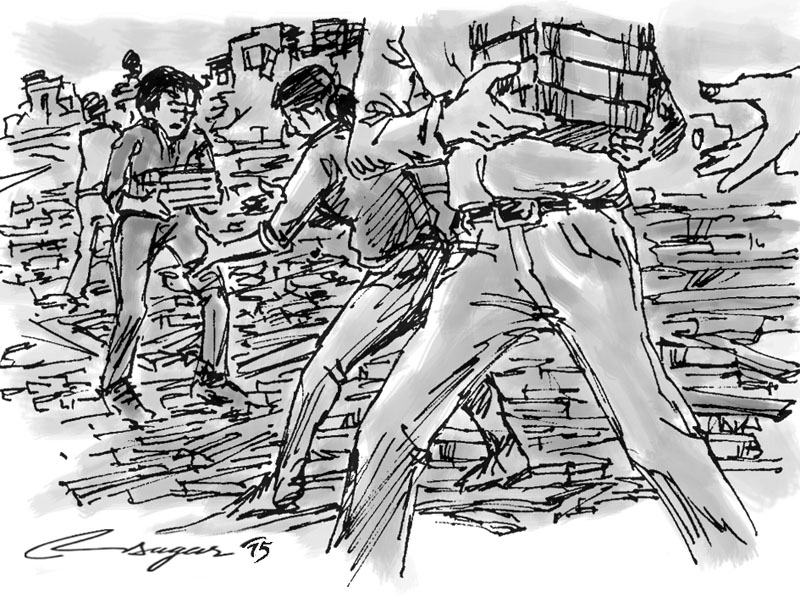Disaster preparedness
Earthquakes don’t kill, but poorly constructed buildings do. That is exactly what happened during the April 25 earthquake. People who fled from their houses survived, those who opted to stay inside lost their lives or got injured
The April 25 Earthquake in Nepal, with devastating consequences, has left many lessons for us to learn. The continuous movement of plates resulting in the continual accumulation of stress along the fault planes puts Nepal in high risk for earthquakes. Therefore, it is better to be prepared for the earthquakes in the future than to be sorry, because it occurs without warning, and we all know this fact very well by now. The Government and people of Nepal can play a key role in achieving that. Nepalese people are known for their complacency. However, adopting a sense of chronic unease and urgency instead of complacency will make a big difference in disaster preparedness and management. The building collapse during the earthquakes and the aftershocks contributed to the majority of the loss of lives and injuries, proving the saying “Earthquakes don’t kill, buildings do.” It also demonstrated that the conventional earthquake safety drill of drop, cover and hold did not work this time around. In contrast, those who fled their homes were able to save their lives.
The crisis led by this catastrophic event brought people together and gave rise to volunteerism, specifically among the youth. This sense of national solidarity and volunteerism needs to continue perpetually, not only at the time of crisis. The international community and the Nepali diaspora stepped in and provided immense help in the rescue and relief of earthquake victims and are now engaged in the restoration process.
Post-quake damage assessment of buildings and infrastructures is very important. The volunteers of Nepal Engineers’ Association did a commendable job in rapid assessment of buildings to assess whether they were fit for habitation. The engineers and scientists from worldwide were also involved in similar assessments of buildings and infrastructures in Nepal.
Nepal could also learn from the earthquake preparedness program in Chile. Chile suffered minimal damage to the buildings and infrastructures and a loss of 13 lives due to the 16 September 2015 earthquake of magnitude 8.3, which is much stronger than the Nepal earthquake of April 25 (magnitude 7.8).
However, there are some positives or silver linings about the April 25 earthquake.The only international airport in Kathmandu was operational and the earthquake did not cause much damage to the highways across the country except the Araniko Highway linking Nepal and China, which suffered landslide related destruction. The banking sector was also open for service during the quake. The international media, including BBC and CNN, gave continuous coverage of the disaster spreading the news across the globe, giving people the idea of the scale of the catastrophe Nepal was facing, and sensitizing the general mass about the urgent need for humanitarian aid for Nepal.
There was no long time interruption in the communication system, so the Nepali diaspora worldwide could keep in touch with their loved ones in Nepal.
The April 25 earthquake occurred on Saturday around noon. Saturday, being a holiday, the schools, colleges, universities and private and government offices were closed, minimizing human casualties.
If the earthquake had exceeded an 8.0 magnitude, human casualties and property damage could have been higher. Earthquakes don’t kill, but poorly constructed buildings do. That is exactly what happened during the April 25 earthquake. People who fled from their houses survived, those who opted to stay inside lost their lives or got injured. This is contrary to the conventional wisdom that people should drop, cover and hold during the earthquake, according to the earthquake safety drills. The great earthquake also triggered avalanches in the higher Himalayas and landslides in the mountainous regions. Almost all houses in the Langtang Valley were turned into rubble.
Some schools in the Kathmandu Valley that were retrofitted survived the earthquake very well indicating how important it is to retrofit the vulnerable buildings, be it a school, college and university, hospital, or a UNESCO World Heritage structure, to make them withstand the tremors without destruction.
The crisis due to the April 25 earthquake also brought illustrious cohesiveness and solidarity among the people in Nepal, which was evident and seen in people helping people, be it relatives, neighbors, social workers, or a volunteer from another country. It also gave rise to a sense of volunteerism in the country, specifically in the youth groups, who wholeheartedly participated in the rescue and relief operations as well as in the recovery and reconstruction efforts. This indicates the dawning of a new era of volunteerism in Nepal, which the government should help foster and continue.
The April 25 earthquake brought tremendous hardship to women, children, elderly and disabled people in the affected areas. It also wreaked havoc to the livestock – countless buffaloes, goats, cows and sheep were killed in the quake.
The lack of elected representatives in the local areas was deeply felt after the April 25 earthquake. They could have played a great role to mobilize rescue and relief operations in the aftermath of the earthquake and provide assistance in the recovery and the reconstruction phase as well.
The writer is President, American Society of Nepalese Engineers (ASNEngr).






